Application of Dual-Frequency Self-Injection Locked DFB Laser for Brillouin Optical Time Domain Analysis
Abstract
:1. Introduction
2. Experimental Setup
3. Results
4. Conclusions
Author Contributions
Funding
Informed Consent Statement
Data Availability Statement
Conflicts of Interest
Appendix A. Dual-Frequency Self-Injection-Locked DFB Laser

Appendix A.1. Laser Configuration and Principle of Operation
Appendix A.1.1. Experimental Laser Configuration
Appendix A.1.2. Operation and Stabilization Mechanisms

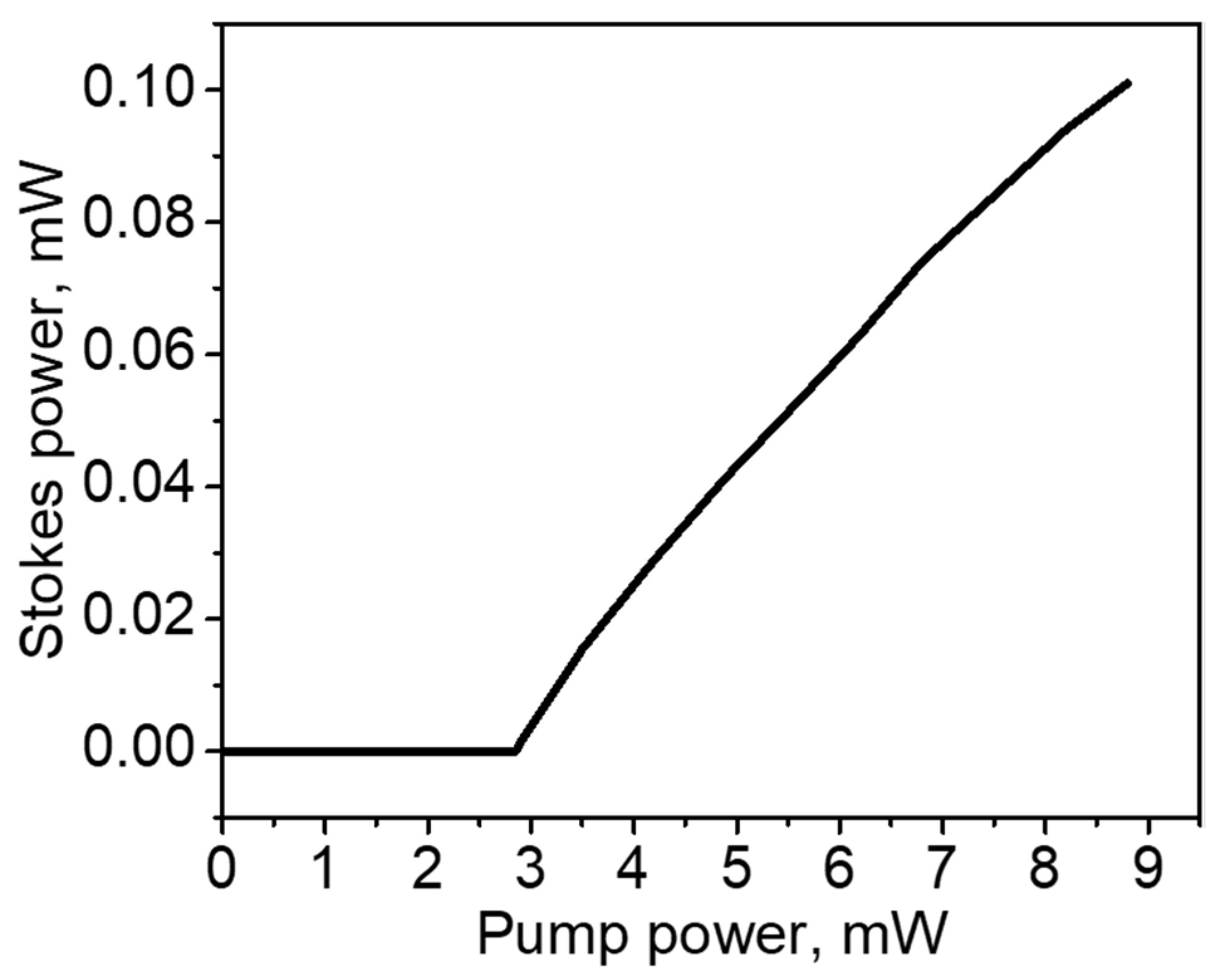
Appendix A.2. Laser Performance Characteristics
Appendix A.2.1. Output Power
Appendix A.2.2. Laser Oscilloscope Traces and Stability against Perturbations
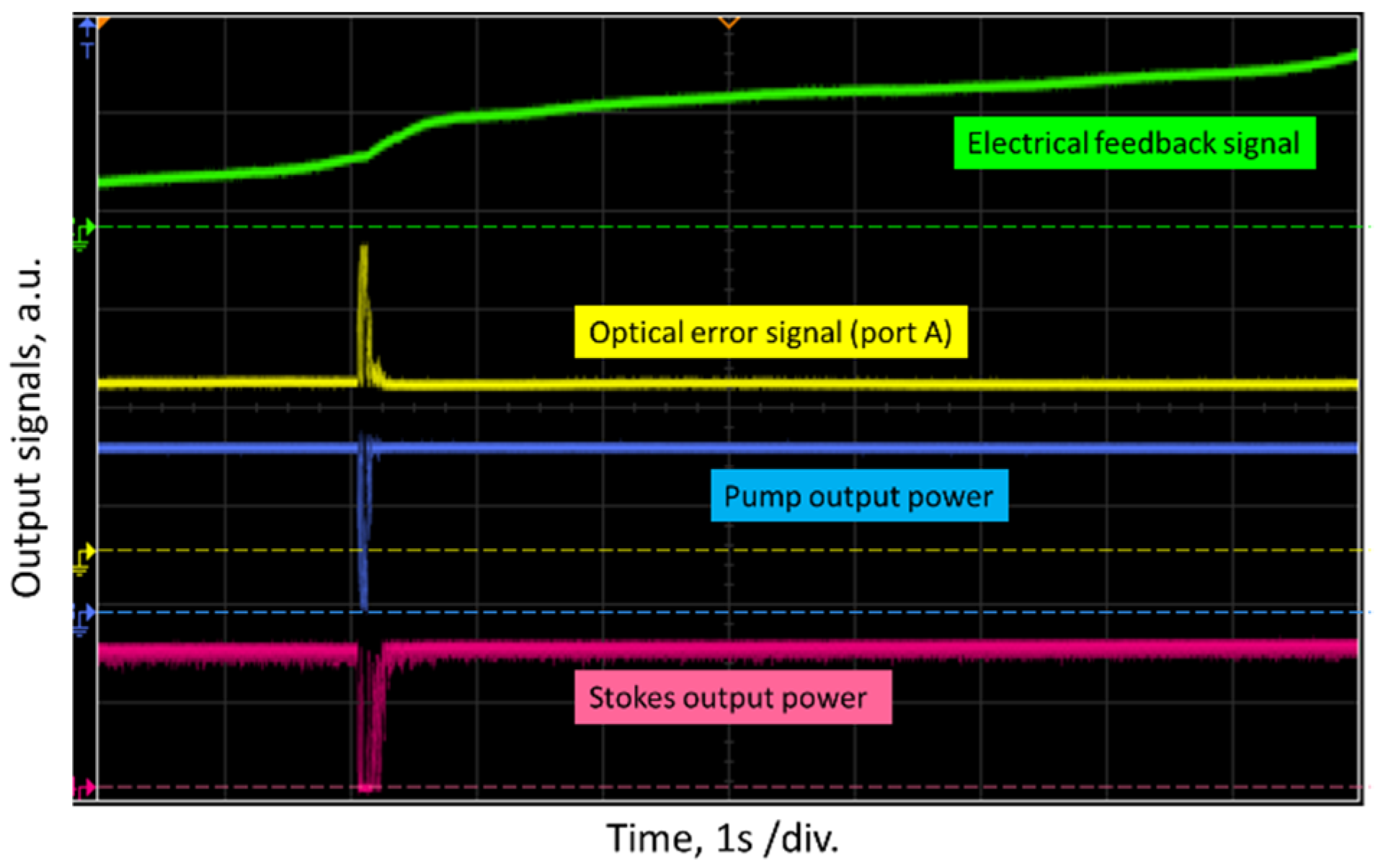
Appendix A.2.3. Laser Polarization States
Appendix A.2.4. Lorentzian Laser Linewidths
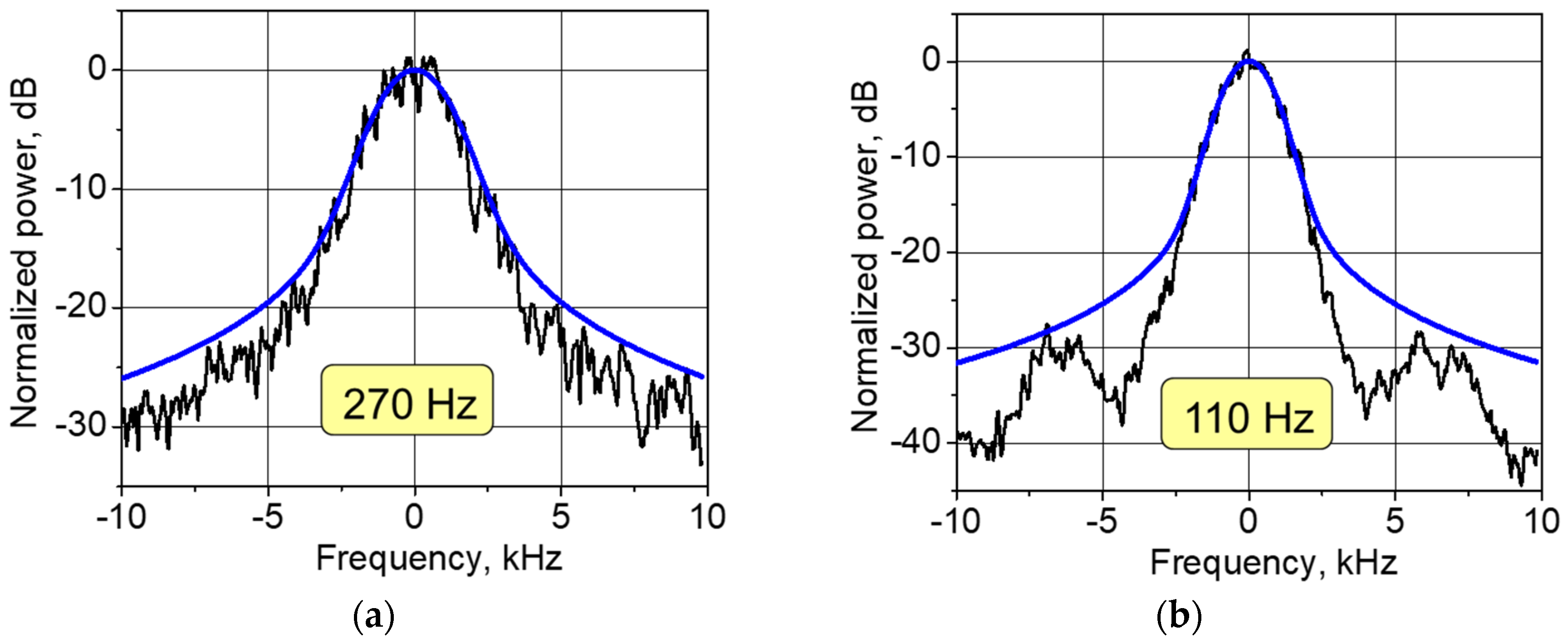
Appendix A.2.5. Noise Performance
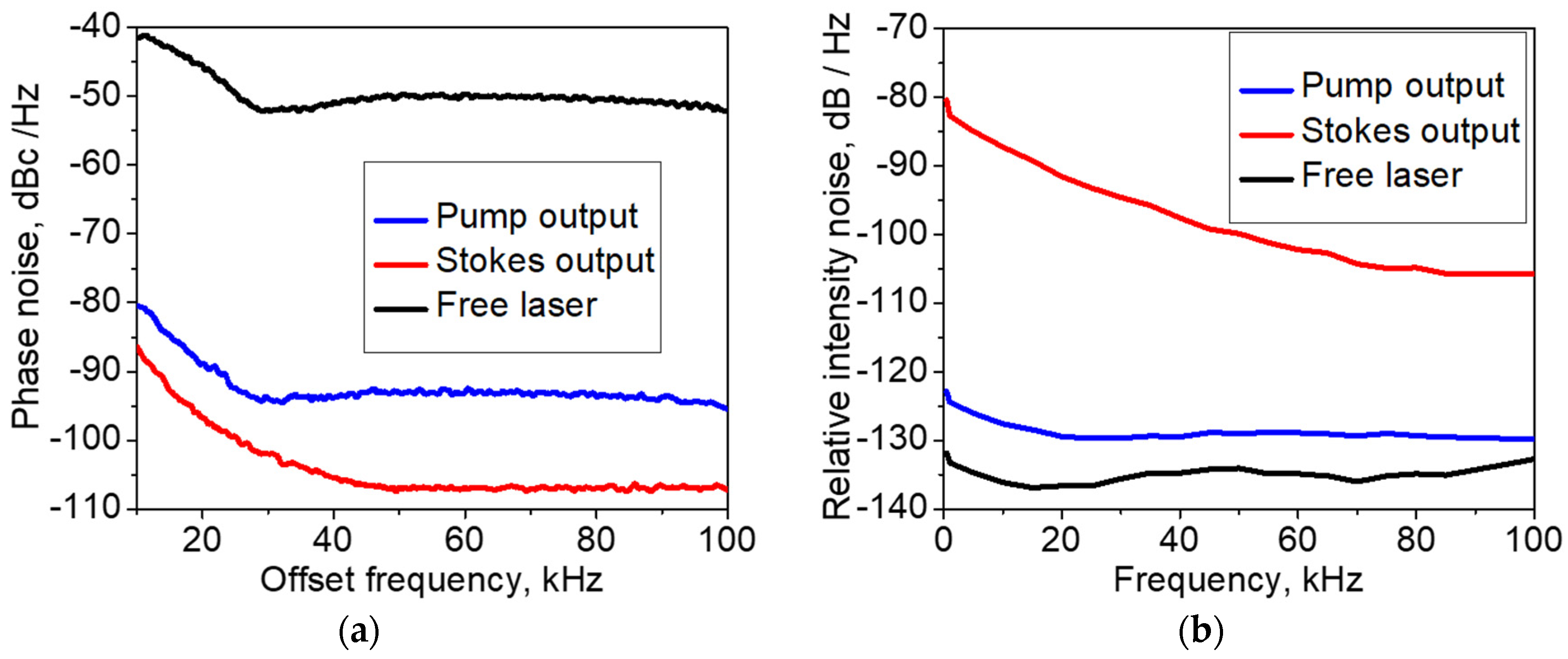
References
- Lee, B. Review of the present status of optical fiber sensors. Opt. Fiber Technol. 2003, 9, 57–79. [Google Scholar] [CrossRef]
- Ahsani, V.; Ahmed, F.; Jun, M.B.; Bradley, C. Tapered fiber-optic Mach-Zehnder interferometer for ultra-high sensitivity measurement of refractive index. Sensors 2019, 19, 1652. [Google Scholar] [CrossRef] [Green Version]
- Fotiadi, A.A.; Brambilla, G.; Ernst, T.; Slattery, S.A.; Nikogosyan, D.N. TPA-induced long-period gratings in a photonic crystal fiber: Inscription and temperature sensing properties. J. Opt. Soc. Am. B Opt. Phys. 2007, 24, 1475–1481. [Google Scholar] [CrossRef]
- Zheng, H.; Zhang, J.; Guo, N.; Zhu, T. Distributed Optical Fiber Sensor for Dynamic Measurement. J. Lightwave Technol. 2021, 39, 3801–3811. [Google Scholar] [CrossRef]
- Bao, X.; Zhou, Z.; Wang, Y. Review: Distributed time-domain sensors based on Brillouin scattering and FWM enhanced SBS for temperature, strain and acoustic wave detection. PhotoniX 2021, 2, 14. [Google Scholar] [CrossRef]
- Faustov, A.V.; Gusarov, A.V.; Mégret, P.; Wuilpart, M.; Zhukov, A.V.; Novikov, S.G.; Svetukhin, V.V.; Fotiadi, A.A. Application of phosphate doped fibers for OFDR dosimetry. Results Phys. 2016, 6, 86–87. [Google Scholar] [CrossRef] [Green Version]
- Ding, Z.; Wang, C.; Liu, K.; Jiang, J.; Yang, D.; Pan, G.; Pu, Z.; Liu, T. Distributed Optical Fiber Sensors Based on Optical Frequency Domain Reflectometry: A review. Sensors 2018, 18, 1072. [Google Scholar] [CrossRef] [Green Version]
- Kurashima, T.; Horiguchi, T.; Tateda, M. Distributed-temperature sensing using stimulated Brillouin scattering in optical silica fibers. Opt. Lett. 1990, 15, 1038–1040. [Google Scholar] [CrossRef] [PubMed]
- Fellay, A.; Thévenaz, L.; Facchini, M.; Niklès, M.; Robert, P. Distributed sensing using stimulated Brillouin scattering: Towards ultimate resolution. In Proceedings of the 12th International Conference on Optical Fiber Sensors, Williamsburg, VA, USA, 28 October 1997; p. OWD3. [Google Scholar]
- Bao, X.; Webb, D.J.; Jackson, D.A. 22-km distributed temperature sensor using Brillouin gain in an optical fiber. Opt. Lett. 1993, 18, 552–554. [Google Scholar] [CrossRef] [PubMed] [Green Version]
- Johny, J.; Amos, S.; Prabhu, R. Optical Fibre-Based Sensors for Oil and Gas Applications. Sensors 2021, 21, 6047. [Google Scholar] [CrossRef]
- Hsu, W.-K.; Lee, Y.-L.; Kuan, T.-T. Brillouin Frequency Shift Sensing Technology Used in Railway Strain and Temperature Measurement. Appl. Sci. 2021, 11, 7101. [Google Scholar] [CrossRef]
- Shen, J.; Li, T.; Zhu, H.; Yang, C.; Zhang, K. Sensing Properties of Fused Silica Single-Mode Optical Fibers Based on PPP-BOTDA in High-Temperature Fields. Sensors 2019, 19, 5021. [Google Scholar] [CrossRef] [Green Version]
- Zhang, D.; Yang, Y.; Xu, J.; Ni, L.; Li, H. Structural Crack Detection Using DPP-BOTDA and Crack-Induced Features of the Brillouin Gain Spectrum. Sensors 2020, 20, 6947. [Google Scholar] [CrossRef] [PubMed]
- Bado, M.F.; Casas, J.R. A Review of Recent Distributed Optical Fiber Sensors Applications for Civil Engineering Structural Health Monitoring. Sensors 2021, 21, 1818. [Google Scholar] [CrossRef]
- Dong, Y. High-Performance Distributed Brillouin Optical Fiber Sensing. Photonic Sens. 2021, 11, 69–90. [Google Scholar] [CrossRef]
- Soto, M.A. Distributed Brillouin Sensing: Time-Domain Techniques; Peng, G.D., Ed.; Springer: Singapore, 2018. [Google Scholar]
- Wang, B.; Dong, Y.; Ba, D.; Bao, X. High spatial resolution: An integrative review of its developments on the Brillouin optical time- and correlation-domain analysis. Meas. Sci. Technol. 2020, 31, 052001. [Google Scholar] [CrossRef]
- Dominguez-Lopez, A.; Soto, M.A.; Martin-Lopez, S.; Thevenaz, L.; Gonzalez-Herraez, M. Resolving 1 million sensing points in an optimized differential time-domain Brillouin sensor. Opt. Lett. 2017, 42, 1903–1906. [Google Scholar] [CrossRef] [PubMed] [Green Version]
- Zhou, D.; Dong, Y.; Wang, B.; Pang, C.; Ba, D.; Zhang, H.; Lu, Z.; Li, H.; Bao, X. Single-shot BOTDA based on an optical chirp chain probe wave for distributed ultrafast measurement. Light Sci. Appl. 2018, 7, 32. [Google Scholar] [CrossRef]
- Brown, A.W.; Smith, J.P.; Bao, X.; Demerchant, M.D.; Bremner, T. Brillouin Scattering Based Distributed Sensors for Structural Applications. J. Intell. Mater. Syst. Struct. 2016, 10, 340–349. [Google Scholar] [CrossRef]
- Nikles, M.; Thevenaz, L.; Robert, P.A. Simple distributed fiber sensor based on Brillouin gain spectrum analysis. Opt. Lett. 1996, 21, 758. [Google Scholar] [CrossRef]
- Iribas, H.; Urricelqui, J.; Mariñelarena, J.; Sagues, M.; Loayssa, A. Cost-Effective Brillouin Optical Time-Domain Analysis Sensor Using a Single Optical Source and Passive Optical Filtering. J. Sens. 2016, 2016, 8243269. [Google Scholar] [CrossRef]
- Song, K.Y.; Yang, S. Simplified Brillouin optical time-domain sensor based on direct modulation of a laser diode. Opt. Express 2010, 18, 24012–24018. [Google Scholar] [CrossRef] [PubMed]
- Bravo, M.; Ullan, A.; Zornoza, A.; Loayssa, A.; Lopez-Amo, M.; Lopez-Higuera, J.M. Application of remote power-by-light switching in a simplified BOTDA sensor network. Sensors 2013, 13, 17434–17444. [Google Scholar] [CrossRef] [PubMed]
- Marini, D.; Iuliano, M.; Bastianini, F.; Bolognini, G. BOTDA Sensing Employing a Modified Brillouin Fiber Laser Probe Source. J. Lightwave Technol. 2018, 36, 1131–1137. [Google Scholar] [CrossRef] [Green Version]
- Rossi, L.; Marini, D.; Bastianini, F.; Bolognini, G. Analysis of enhanced-performance fibre Brillouin ring laser for Brillouin sensing applications. Opt. Express 2019, 27, 29448–29459. [Google Scholar] [CrossRef] [PubMed]
- Rossi, L.; Marini, D.; Bastianini, F.; Bolognini, G. Enhanced performance short cavity Brillouin fiber ring laser for high-stability BOTDA sensing. In Proceedings of the 2020 IEEE Sensors, San Jose, CA, USA, 25–28 October 2020; pp. 1–4. [Google Scholar]
- Spirin, V.V.; Lopez-Mercado, C.A.; Mégret, P.; Korobko, D.A.; Zolotovskii, I.O.; Fotiadi, A.A. Stabilizing Brillouin fiber laser for applications in distributed BOTDA sensing. In Proceedings of the Optical Sensors 2021, Online Conference, 18 April 2021; p. 1177207. [Google Scholar]
- Bueno Escobedo, J.L.; Spirin, V.V.; López-Mercado, C.A.; Mégret, P.; Zolotovskii, I.O.; Fotiadi, A.A. Self-injection locking of the DFB laser through an external ring fiber cavity: Polarization behavior. Results Phys. 2016, 6, 59–60. [Google Scholar] [CrossRef] [Green Version]
- Bueno Escobedo, J.L.; Spirin, V.V.; López-Mercado, C.A.; Márquez Lucero, A.; Mégret, P.; Zolotovskii, I.O.; Fotiadi, A.A. Self-injection locking of the DFB laser through an external ring fiber cavity: Application for phase sensitive OTDR acoustic sensor. Results Phys. 2017, 7, 641–643. [Google Scholar] [CrossRef]
- Bueno Escobedo, J.L.; Jason, J.; López-Mercado, C.A.; Spirin, V.V.; Wuilpart, M.; Mégret, P.; Korobko, D.A.; Zolotovskiy, I.O.; Fotiadi, A.A. Distributed measurements of vibration frequency using phase-OTDR with a DFB laser self-stabilized through PM fiber ring cavity. Results Phys. 2019, 12, 1840–1842. [Google Scholar] [CrossRef]
- Spirin, V.V.; Bueno Escobedo, J.L.; Korobko, D.A.; Mégret, P.; Fotiadi, A.A. Dual-frequency laser comprising a single fiber ring cavity for self-injection locking of DFB laser diode and Brillouin lasing. Opt. Express 2020, 28, 37322–37333. [Google Scholar] [CrossRef]
- Spirin, V.V.; Bueno Escobedo, J.L.; Korobko, D.A.; Mégret, P.; Fotiadi, A.A. Stabilizing DFB laser injection-locked to an external fiber-optic ring resonator. Opt. Express 2020, 28, 478–484. [Google Scholar] [CrossRef] [PubMed]
- Stiller, B.; Kudlinski, A.; Lee, M.W.; Bouwmans, G.; Delque, M.; Beugnot, J.-C.; Maillotte, H.; Sylvestre, T. SBS Mitigation in a Microstructured Optical Fiber by Periodically Varying the Core Diameter. IEEE Photonics Technol. Lett. 2012, 24, 667–669. [Google Scholar] [CrossRef]
- Spirin, V.V.; Bueno Escobedo, J.L.; Miridonov, S.V.; Maya Sánchez, M.C.; López-Mercado, C.A.; Korobko, D.A.; Zolotovskii, I.O.; Fotiadi, A.A. Sub-kilohertz Brillouin fiber laser with stabilized self-injection locked DFB pump laser. Opt. Laser Technol. 2021, 141, 107156. [Google Scholar] [CrossRef]
- López-Mercado, C.A.; Spirin, V.V.; Kablukov, S.I.; Zlobina, E.A.; Zolotovskiy, I.O.; Mégret, P.; Fotiadi, A.A. Accuracy of single-cut adjustment technique for double resonant Brillouin fiber lasers. Opt. Fiber Technol. 2014, 20, 194–198. [Google Scholar] [CrossRef]
- Korobko, D.A.; Zolotovskii, I.O.; Panajotov, K.; Spirin, V.V.; Fotiadi, A.A. Self-injection-locking linewidth narrowing in a semiconductor laser coupled to an external fiber-optic ring resonator. Opt. Commun. 2017, 405, 253–258. [Google Scholar] [CrossRef]
- Derickson, D.; Hentschel, C.; Vobis, J. Fiber Optic Test and Measurement; Prentice Hall: Hoboken, NJ, USA, 1998; Volume 8. [Google Scholar]
- Mercer, L.B. 1/f Frequency Noise Effects on Self-Heterodyne Linewidth Measurements. IEEE Lightwave Technol. 1991, 9, 485–493. [Google Scholar] [CrossRef] [Green Version]
- Chen, M.; Meng, Z.; Wang, J.; Chen, W. Ultra-narrow linewidth measurement based on Voigt profile fitting. Opt. Express 2015, 23, 6803–6808. [Google Scholar] [CrossRef]
- Camatel, S.; Ferrero, V. Narrow Linewidth CW Laser Phase Noise Characterization Methods for Coherent Transmission System Applications. J. Lightwave Technol. 2008, 26, 3048–3055. [Google Scholar] [CrossRef] [Green Version]
- Llopis, O.; Merrer, P.H.; Brahimi, H.; Saleh, K.; Lacroix, P. Phase noise measurement of a narrow linewidth CW laser using delay line approaches. Opt. Lett. 2011, 36, 2713–2715. [Google Scholar] [CrossRef] [Green Version]
- Li, Y.; Fu, Z.; Zhu, L.; Fang, J.; Zhu, H.; Zhong, J.; Xu, P.; Chen, X.; Wang, J.; Zhan, M. Laser frequency noise measurement using an envelope-ratio method based on a delayed self-heterodyne interferometer. Opt. Commun. 2019, 435, 244–250. [Google Scholar] [CrossRef]
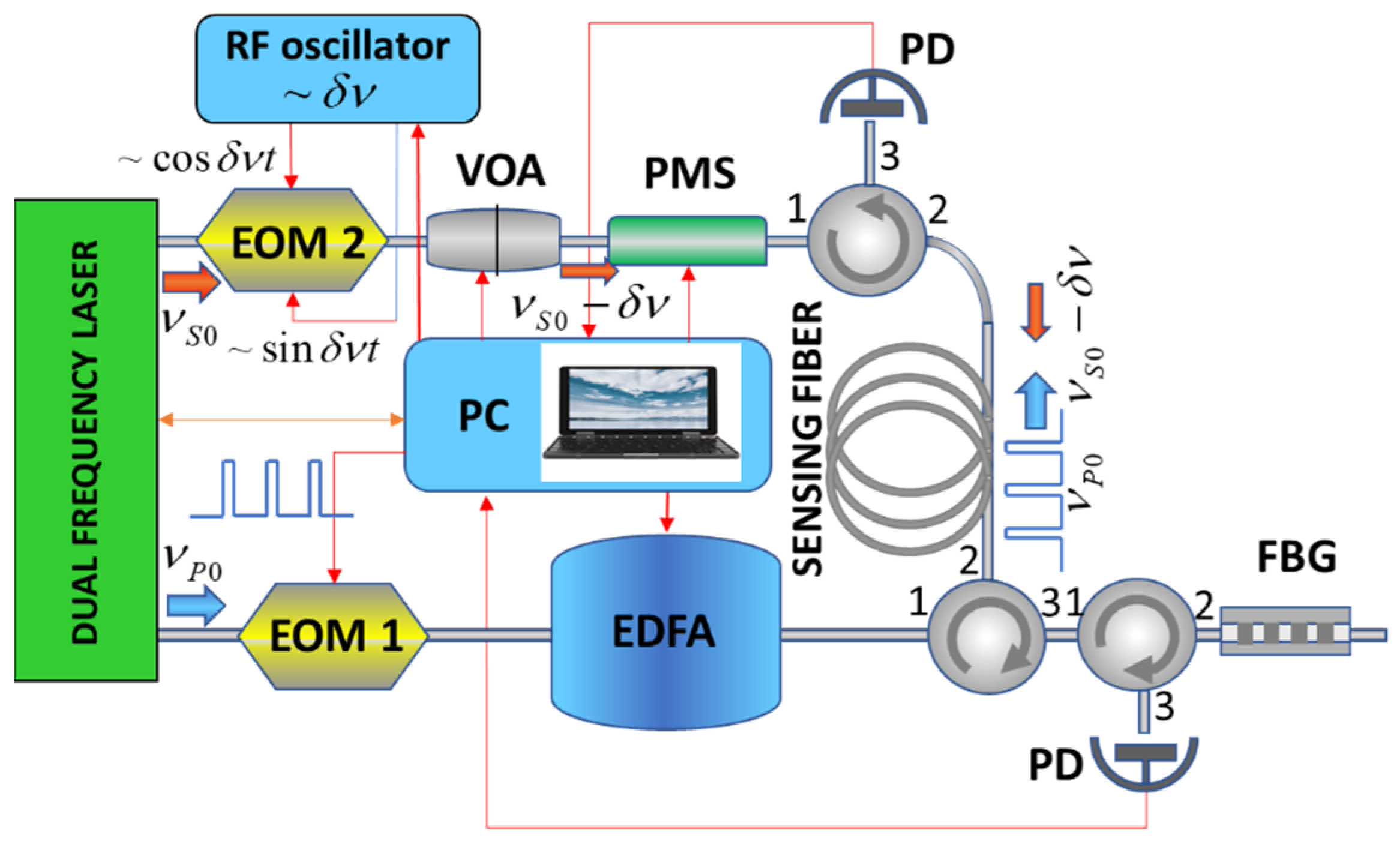

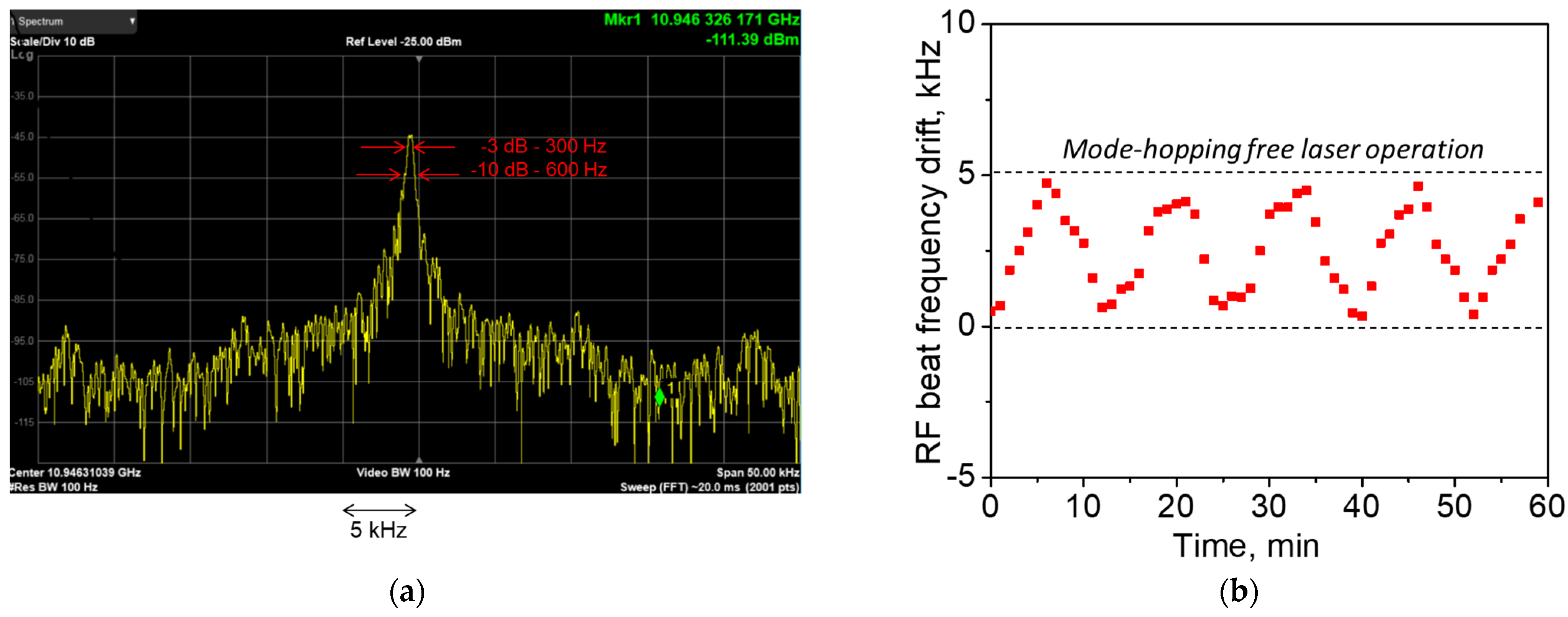

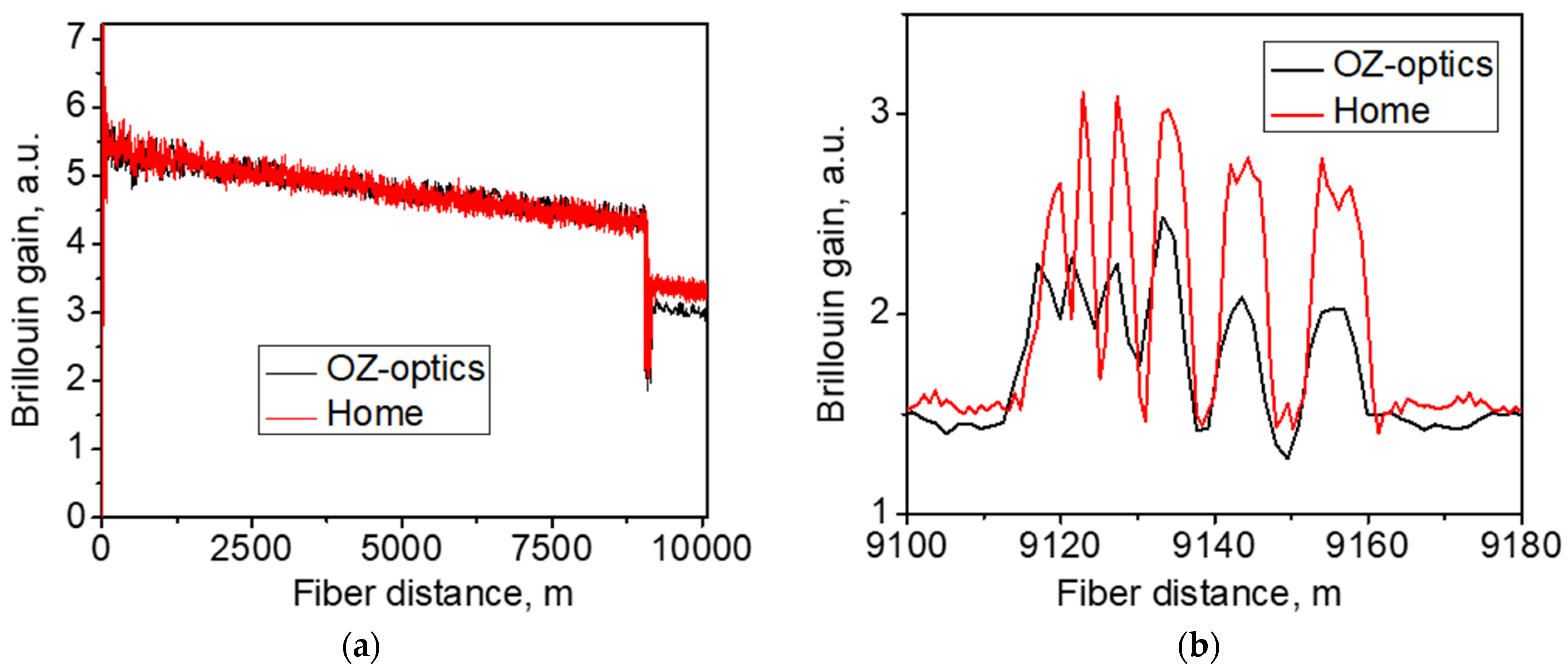

Publisher’s Note: MDPI stays neutral with regard to jurisdictional claims in published maps and institutional affiliations. |
© 2021 by the authors. Licensee MDPI, Basel, Switzerland. This article is an open access article distributed under the terms and conditions of the Creative Commons Attribution (CC BY) license (https://creativecommons.org/licenses/by/4.0/).
Share and Cite
Lopez-Mercado, C.A.; Korobko, D.A.; Zolotovskii, I.O.; Fotiadi, A.A. Application of Dual-Frequency Self-Injection Locked DFB Laser for Brillouin Optical Time Domain Analysis. Sensors 2021, 21, 6859. https://doi.org/10.3390/s21206859
Lopez-Mercado CA, Korobko DA, Zolotovskii IO, Fotiadi AA. Application of Dual-Frequency Self-Injection Locked DFB Laser for Brillouin Optical Time Domain Analysis. Sensors. 2021; 21(20):6859. https://doi.org/10.3390/s21206859
Chicago/Turabian StyleLopez-Mercado, Cesar A., Dmitry A. Korobko, Igor O. Zolotovskii, and Andrei A. Fotiadi. 2021. "Application of Dual-Frequency Self-Injection Locked DFB Laser for Brillouin Optical Time Domain Analysis" Sensors 21, no. 20: 6859. https://doi.org/10.3390/s21206859
APA StyleLopez-Mercado, C. A., Korobko, D. A., Zolotovskii, I. O., & Fotiadi, A. A. (2021). Application of Dual-Frequency Self-Injection Locked DFB Laser for Brillouin Optical Time Domain Analysis. Sensors, 21(20), 6859. https://doi.org/10.3390/s21206859





